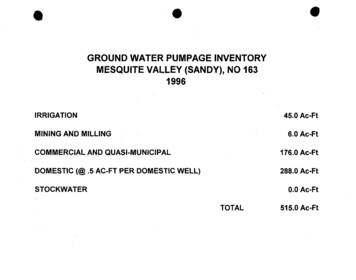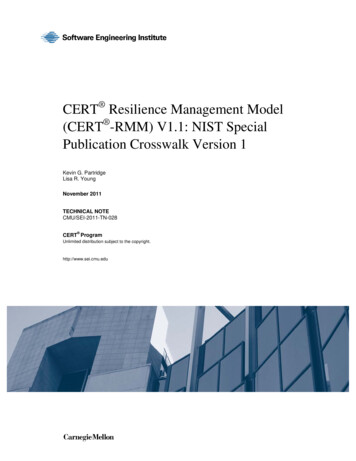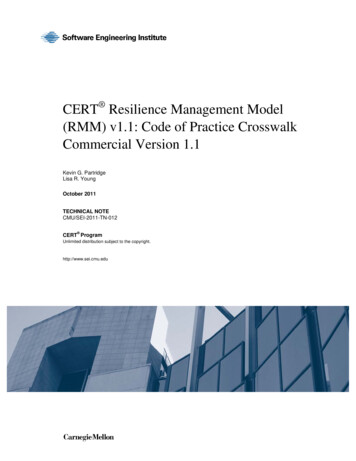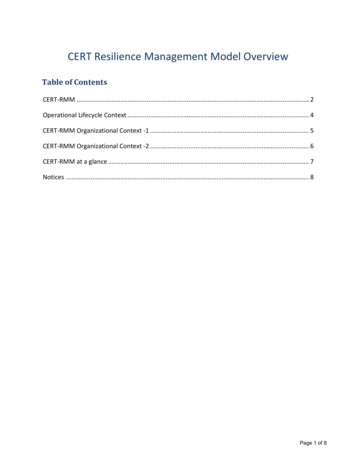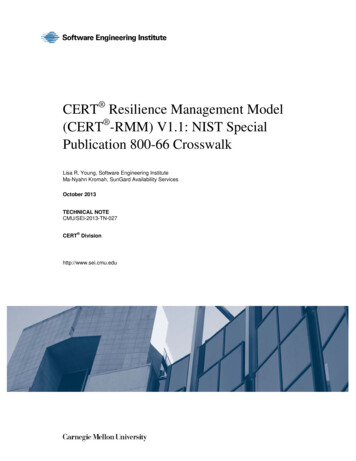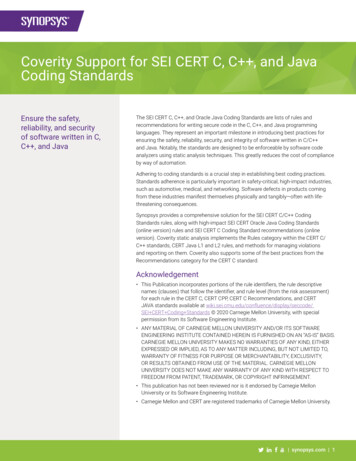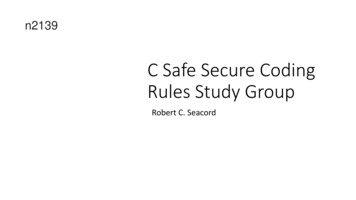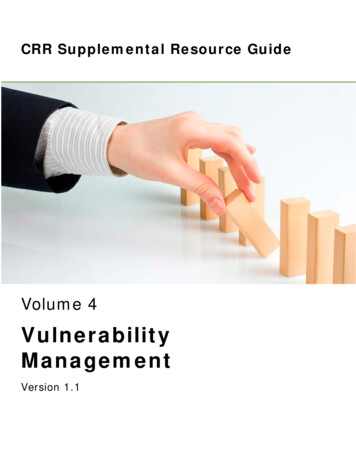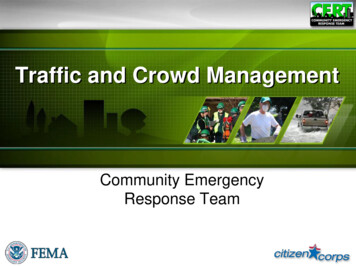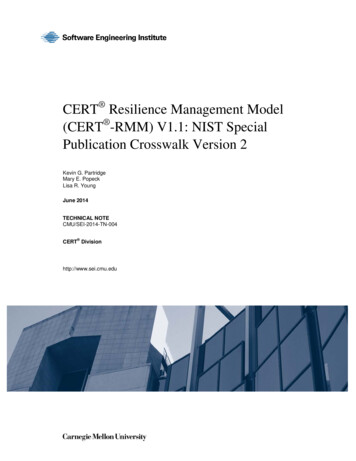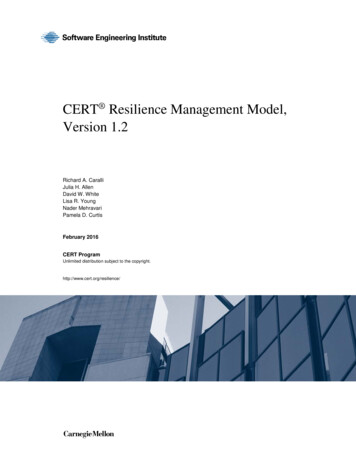
Transcription
CERT Resilience Management Model,Version 1.2Richard A. CaralliJulia H. AllenDavid W. WhiteLisa R. YoungNader MehravariPamela D. CurtisFebruary 2016CERT ProgramUnlimited distribution subject to the copyright.http://www.cert.org/resilience/
Copyright 2016 Carnegie Mellon UniversityThis material is based upon work funded and supported by various entities under Contract No. FA8721-05-C-0003 with CarnegieMellon University for the operation of the Software Engineering Institute, a federally funded research and development centersponsored by the United States Department of Defense.Any opinions, findings and conclusions or recommendations expressed in this material are those of the author(s) and do notnecessarily reflect the views of Various or the United States Department of Defense.NO WARRANTY. THIS CARNEGIE MELLON UNIVERSITY AND SOFTWARE ENGINEERING INSTITUTEMATERIAL IS FURNISHED ON AN “AS-IS” BASIS. CARNEGIE MELLON UNIVERSITY MAKES NO WARRANTIESOF ANY KIND, EITHER EXPRESSED OR IMPLIED, AS TO ANY MATTER INCLUDING, BUT NOT LIMITED TO,WARRANTY OF FITNESS FOR PURPOSE OR MERCHANTABILITY, EXCLUSIVITY, OR RESULTS OBTAINED FROMUSE OF THE MATERIAL. CARNEGIE MELLON UNIVERSITY DOES NOT MAKE ANY WARRANTY OF ANY KINDWITH RESPECT TO FREEDOM FROM PATENT, TRADEMARK, OR COPYRIGHT INFRINGEMENT.[Distribution Statement A] This material has been approved for public release and unlimited distribution. Please see Copyrightnotice for non-US Government use and distribution.Internal use:* Permission to reproduce this material and to prepare derivative works from this material for internal use is granted,provided the copyright and “No Warranty” statements are included with all reproductions and derivative works.External use:* This material may be reproduced in its entirety, without modification, and freely distributed in written orelectronic form without requesting formal permission. Permission is required for any other external and/or commercial use.Requests for permission should be directed to the Software Engineering Institute at permission@sei.cmu.edu.* These restrictions do not apply to U.S. government entities.Carnegie Mellon and CERT are registered marks of Carnegie Mellon University.DM-0003234
CERT Resilience Management Model,Version 1.2Asset Definition and Management (ADM)Richard A. CaralliJulia H. AllenDavid W. WhiteLisa R. YoungNader MehravariPamela D. CurtisFebruary 2016CERT ProgramUnlimited distribution subject to the copyright.http://www.cert.org/resilience/
Copyright 2016 Carnegie Mellon UniversityThis material is based upon work funded and supported by various entities under Contract No. FA8721-05-C-0003 with CarnegieMellon University for the operation of the Software Engineering Institute, a federally funded research and development centersponsored by the United States Department of Defense.Any opinions, findings and conclusions or recommendations expressed in this material are those of the author(s) and do notnecessarily reflect the views of Various or the United States Department of Defense.NO WARRANTY. THIS CARNEGIE MELLON UNIVERSITY AND SOFTWARE ENGINEERING INSTITUTEMATERIAL IS FURNISHED ON AN “AS-IS” BASIS. CARNEGIE MELLON UNIVERSITY MAKES NO WARRANTIESOF ANY KIND, EITHER EXPRESSED OR IMPLIED, AS TO ANY MATTER INCLUDING, BUT NOT LIMITED TO,WARRANTY OF FITNESS FOR PURPOSE OR MERCHANTABILITY, EXCLUSIVITY, OR RESULTS OBTAINED FROMUSE OF THE MATERIAL. CARNEGIE MELLON UNIVERSITY DOES NOT MAKE ANY WARRANTY OF ANY KINDWITH RESPECT TO FREEDOM FROM PATENT, TRADEMARK, OR COPYRIGHT INFRINGEMENT.[Distribution Statement A] This material has been approved for public release and unlimited distribution. Please see Copyrightnotice for non-US Government use and distribution.Internal use:* Permission to reproduce this material and to prepare derivative works from this material for internal use is granted,provided the copyright and “No Warranty” statements are included with all reproductions and derivative works.External use:* This material may be reproduced in its entirety, without modification, and freely distributed in written orelectronic form without requesting formal permission. Permission is required for any other external and/or commercial use.Requests for permission should be directed to the Software Engineering Institute at permission@sei.cmu.edu.* These restrictions do not apply to U.S. government entities.Carnegie Mellon and CERT are registered marks of Carnegie Mellon University.DM-0003234
CERT-RMMVersion 1.2ASSET DEFINITION AND MANAGEMENTEngineeringPurposeThe purpose of Asset Definition and Management is to identify, document, and manageorganizational assets during their life cycle to ensure sustained productivity to supportorganizational services.Introductory NotesMission success for an organization relies on the success of each service in achieving itsmission. In turn, mission assurance for services depends on the availability, productivity, andultimately the resilience of high-value assets that the service relies upon—people to performand monitor the service, information to fuel the service, technology to support the automationof the service, and facilities in which to operate the service. Whenever any high-value assetis affected by disruptive events (by the realization of operational risk), the assurance of themission is less certain and predictable. An organization must be able to identify its high-valueassets, document them, and establish their value in order to develop strategies for protectingand sustaining assets commensurate with their value to services.The Asset Definition and Management process area seeks to establish organizational assetsas the focus of the operational resilience management system. High-value organizationalassets are identified and profiled (establishing ownership, a common definition, and value),and the relationship between the assets and the organizational services they support isestablished. The organization also defines and manages the process for keeping the assetinventory current and ensures that changes to the inventory do not result in gaps instrategies for protecting and sustaining assets.The Asset Definition and Management process area is a higher order competency thatestablishes the inventory of high-value organizational assets of all types. The resilienceaspects of these assets (and their related services) are addressed in asset-specific processareas as noted in “Related Process Areas” below.The Asset Definition and Management process area has three specific goals: to inventoryassets, associate the assets with services, and manage the assets. To meet these goals, theorganization must engage in the following practices: Establish a means to identify and document assets. Establish ownership and custodianship for the assets. Link assets to the services they support. Establish resilience requirements (including those for protecting and sustaining) forassets and associated services. (This is addressed in the Resilience RequirementsDefinition and Resilience Requirements Management process areas.) Provide change management processes for assets as they change and as the inventoryof assets changes.CERT Resilience Management ModelADM 1
CERT-RMMVersion 1.2 Establish risk management processes to identify, analyze, and mitigate risks to highvalue assets. (This is addressed in the Risk Management process area.) Establish continuity processes to develop, test, and implement service continuity andrestoration plans for high-value assets. (This is addressed in the Service Continuityprocess area.) Monitor the extent to which high-value assets are adequately protected and sustained,and develop and implement adjustments as necessary. (This is addressed in theMonitoring process area.)Related Process AreasThe identification, documentation, analysis, and management of asset-level resiliencerequirements are addressed in the Resilience Requirements Development and ResilienceRequirements Management process areas.The identification, assessment, and mitigation of risks to high-value assets are addressed inthe Risk Management process area.The development, implementation, and management of strategies for protecting people areaddressed in the People Management process area.The development, implementation, and management of strategies for protecting informationassets are addressed in the Knowledge and Information Management process area.The development, implementation, and management of strategies for protecting technologyassets are addressed in the Technology Management process area.The development, implementation, and management of strategies for protecting facilityassets are addressed in the Environmental Control process area.The development and implementation of service continuity plans for high-value assets andtheir related services are performed in the Service Continuity process area. Servicecontinuity plans describe strategies for sustaining high-value assets and services.The identification and prioritization of high-value organizational services are performed in theEnterprise Focus process area.Summary of Specific Goals and PracticesGoalsPracticesADM:SG1 Establish Organizational AssetsADM:SG1.SP1 Inventory AssetsADM:SG1.SP2 Establish a Common UnderstandingADM:SG1.SP3 Establish Ownership and CustodianshipADM:SG2 Establish the Relationship BetweenAssets and ServicesADM:SG2.SP1 Associate Assets with ServicesADM:SG3 Manage AssetsADM:SG3.SP1 Identify Change CriteriaADM:SG2.SP2 Analyze Asset-Service DependenciesADM:SG3.SP2 Maintain Changes to Assets and InventoryADM 2CERT Resilience Management Model
CERT-RMMVersion 1.2Specific Practices by GoalADM:SG1 Establish Organizational AssetsOrganizational assets (people, information, technology, and facilities) areidentified and the authority and responsibility for these assets areestablished.The assets of the organization must be identified, prioritized, documented, andinventoried.The highest-level concept in the operational resilience management system is a service.Services are defined as the limited number of activities that the organization carries outin the performance of a duty or in the production of a product. Services are the primeresource that the organization uses to accomplish its mission. Each service has amission that must be accomplished in order to support the organization’s strategicobjectives. Failure to accomplish the mission of a service is a potentially seriousimpediment to accomplishing the organization’s mission.An important aspect of services is that they are “fueled” by assets—the raw materialsthat services need to operate.A service cannot accomplish its mission unless there are people to operate and monitor the service information and data to feed the process and to be produced by the service technology to automate and support the service facilities in which to perform the serviceThese assets may or may not be directly owned by the organization. For example,outsourcing of call center functions may mean that the organization does not control thepeople, information, technology, or facilities that enable the service; however, theorganization retains responsibility for the ownership and resilience of the assets. Inorder to properly determine resilience requirements (and to implement appropriatestrategies for protecting and sustaining assets), the organization must define theseassets from a service perspective and establish ownership and responsibility for theirresilience.ADM:SG1.SP1 Inventory AssetsOrganizational assets are identified and inventoried.Success at achieving the organization’s mission relies upon criticaldependencies between organizational goals and objectives, services, andassociated high-value assets. Lack of performance of these assets (due todisruptive events, realized risk, or other issues) impedes mission assuranceof associated services and can translate into failure to achieveorganizational goals and objectives. Thus, ensuring the operationalresilience of high-value assets is paramount to organizational success.The first step in establishing the operational resilience of assets is toidentify and define the assets. Because assets derive their value andimportance through their association with services, the organization mustfirst identify and establish which services are of high value. This providesCERT Resilience Management ModelADM 3
CERT-RMMVersion 1.2structure and guidance for developing an inventory of high-value assets forwhich resilience requirements have to be established and satisfied.Inventorying these assets is also essential to ensuring that changes aremade in resilience requirements as operational and environmental changesoccur.Establishing criteria for determining the value of services and associatedassets is performed in the Risk Management process area. Identifying andprioritizing high-value organizational services are performed in theEnterprise Focus process area.Each type of asset for a specific service must be identified and inventoried.The following are descriptions of the four asset types.People are those who are vital to the expected operation and performanceof the service. They execute the process and monitor it to ensure that it isachieving its mission, and make corrections to the process when necessaryto bring it back on track. People may be internal or external to theorganization.Information is any information or data, on any media including paper orelectronic form, that is vital to the intended operation of the service.Information may also be the output or by-product of the execution of aservice. Information can be as small as a bit or a byte, a record or a file, oras large as a database. (The organization must determine how granularly todefine information with respect to its purpose in a service.) Because ofconfidentiality and privacy concerns, information must also be categorizedas to its organizational sensitivity. Categorization provides another level ofimportant description to an information asset that may affect strategies toprotect and sustain it. Examples of information include Social Securitynumbers, a vendor database, intellectual property, and institutionalknowledge.Technology describes any technology component or asset that supports orautomates a service and facilitates its ability to accomplish its mission.Technology has many layers, some that are specific to a service (such asan application system) and others that are shared by the organization (suchas the enterprise-wide network infrastructure) to support more than oneservice. Organizations must describe technology assets in terms thatfacilitate development and satisfaction of resilience requirements. In someorganizations, this may be at the application system level; in others, it mightbe more granular, such as at the server or personal computer level.Examples of technology assets include software, hardware, and firmware,including physical interconnections between these assets such as cabling.Facilities are any physical plant assets that the organization relies upon toexecute a service. Facilities are the places where services are executedand can be owned and controlled by the organization or by externalbusiness partners. Facilities are also often shared such that more than oneservice is executed in and dependent upon them. (For example, aheadquarters office building has a substantial number of services beingexecuted inside of it.) Facilities provide the physical space for the actions ofpeople, the use and storage of information, and the operations ofADM 4CERT Resilience Management Model
CERT-RMMVersion 1.2technology components. Thus, resilience planning for facilities mustintegrate tightly with planning for the other assets. Examples of facilitiesinclude office buildings, data centers, and other real estate where servicesare performed.Organizations may use many practical methods to inventory these assets.Human resources databases identify and describe the roles of vital staff.Fixed asset catalogs often describe all levels of technology components.Facilities and real estate databases have information about high-valuephysical plant assets. However, bear in mind that internal databases maynot cover people, technology, and facilities that are not under the directcontrol of the organization. In contrast to people, technology, and facilities,less tangible assets such as information and intellectual property may notbe identified and regularly inventoried because they are often difficult todescribe and bound. For example, a staff member may have informationthat is critical to the effective operation of a service that has not beendocumented or is not known to other staff members. This must be resolvedin order to properly define security and continuity requirements for theseassets.Typical work products1.Asset inventory (of all high-value assets of each type)2.Asset repository or database(s)Subpractices1.Identify and inventory vital staff.2.Identify and inventory high-value information assets.3.Identify and inventory high-value technology components.4.Identify and inventory high-value facilities.5.Develop and maintain asset database(s) for all high-value assets.All information relevant to the asset should be contained with the asset in its entry inthe appropriate asset database(s). Operational access to and integrity of the inventoryinformation is the main factor, whether or not there is one or more than one masterrepository or database for all assets.ADM:SG1.SP2 Establish a Common UnderstandingA common and consistent definition of assets is established andcommunicated.Proper description of organizational assets is essential to ensuring acommon understanding of these assets between owners and custodians.(The difference between owners and custodians is explained inADM:SG1.SP3.) A consistent description aids in developing resiliencerequirements and ensuring satisfaction of these requirements. It defines theboundaries and extent of the asset, which is useful for defining ownershipand responsibility for the resilience of the asset. In addition, an asset’sdescription can be easily communicated within and outside of theCERT Resilience Management ModelADM 5
CERT-RMMVersion 1.2organization to facilitate communication of resilience requirements tointernal constituencies and external business partners.At a minimum, all high-value assets (as identified in ADM:SG1.SP1) shouldbe defined to the extent possible. Differences in the level of description areexpected from asset to asset, and an organization must decide how muchinformation is useful in facilitating requirements definition and satisfaction.The description of the asset should detail why it is considered to be of highvalue to the organization. There are some common elements that should becollected, at a minimum, for each asset.These are examples of information that should be collected and documented for assets: asset type (people, information, technology, or facilities) categorization of asset by sensitivity (generally for information assets only) asset location (typically where the custodian is managing the asset) asset owners and custodians (particularly where this is external to the organization) the format or form of the asset (particularly for information assets that might exist onpaper and electronically) location where backups or duplicates of this asset exist (particularly for informationassets) the services that are dependent on the asset (See ADM:SG2.) the value of the asset in either qualitative or quantitative termsAn organization may also choose to document the asset’s resiliencerequirements as part of the asset profile so that there is a common sourcefor communicating and updating these requirements and so that theirassociation with an asset is established. In addition, strategies to protectand sustain an asset may be documented as part of the asset profile.(Resilience requirements for assets are developed and documented in theResilience Requirements Development process area.)There are additional considerations for describing each type of asset.PeopleIn describing people, be sure to describe a role where possible, rather than theactual persons who perform the role. If a particular person or persons in theorganization are vital to the successful operation of a service because of theirdetailed knowledge and experience, this should be noted in the description ofthe asset. This may affect the resilience requirements of the asset whendefined.Information AssetsBecause information is an intangible asset, it must be accurately described.Some organizations find media conventions such as record, file, and databaseto be natural limiters of the description of an information asset. Informationasset descriptions should also address the level of sensitivity of the assetbased on the organization’s categorization scheme. This will aid in ensuringthat confidentiality and privacy sensitivities are considered in the developmentand satisfaction of resilience requirements.ADM 6CERT Resilience Management Model
CERT-RMMVersion 1.2Technology and Facilities AssetsOrganizations often view technology components and facilities as sharedenterprise assets. This should be considered when defining these assets andwhen developing resilience requirements. In addition, because technology andfacilities are tangible assets, the current value of the asset should be includedin the definition. This will provide additional data on the value of the asset to theorganization and serve as a guide for comparing value versus cost of activitiesto protect and sustain assets.Typical work products1.Asset profiles (for all high-value assets of each type)2.Updated asset database(s) (including asset profiles)Subpractices1. Create an asset profile for each high-value asset (or similar workproduct) and document a common description.Be sure to address the entire range of information that should be collected for eachtype of asset, including at a minimum the owner and the custodian(s) of the asset.Also, include the resilience requirements of the asset as established or acquired by theorganization. (Refer to the Resilience Requirements Development process area formore information.)2.Describe and document the “acceptable use” of the asset. Ensurealignment between acceptable uses and resilience requirements.3.Categorize information assets as to their level of sensitivity.4.Update the asset database(s) with asset profile information.All information relevant to the asset (collected from the asset profile) should becontained with the asset in its entry in the appropriate asset database.ADM:SG1.SP3 Establish Ownership and CustodianshipAuthority and responsibility for assets are established.High-value assets have owners and custodians. Asset owners are thepersons or organizational units, internal or external to the organization, thathave primary responsibility for the viability, productivity, and resilience ofthe asset. For example, an information asset such as customer data maybe owned by the “customer relations department” or the “customerrelationship manager.” It is the owner’s responsibility to ensure that theappropriate levels of confidentiality, integrity, and availability requirementsare defined and satisfied to keep the asset productive and viable for use inservices.Asset custodians are persons or organizational units, internal or external tothe organization, that are responsible for implementing and managingcontrols to satisfy the resilience requirements of high-value assets whilethey are in their care. For example, the customer data in the above examplemay be stored on a server that is maintained by the IT department. Inessence, the IT department takes custodial control of the customer dataasset when the asset is in its domain. The IT department must commit toCERT Resilience Management ModelADM 7
CERT-RMMVersion 1.2taking actions commensurate with satisfying the owner’s requirements toprotect and sustain the asset. However, in all cases, owners areresponsible for ensuring that their assets are properly protected andsustained, regardless of the actions (or inactions) of custodians.In practice, custodianship brings many challenges for asset owners inensuring that the resilience requirements of their assets are being satisfied.In some cases, custodians of assets must resolve conflicting requirementsobtained from more than one asset owner. This can occur in cases where aserver contains more than one information asset from different owners withunique and sometimes competing requirements. In addition, custodianshipmay occur outside of organizational boundaries, as is commonly seen inoutsourcing arrangements. In such a case, asset owners must clearlycommunicate the resilience requirements of their assets to externalcustodians and must expend additional effort in monitoring the satisfactionof those requirements.The owner of each high-value asset is established in order to defineresponsibility and accountability for the asset’s resilience and itscontributions to services. Accordingly, owners are responsible fordeveloping and validating the resilience requirements for high-value assetsthat they own. They are also responsible for the implementation of propercontrols to meet resilience requirements, even if they assign thisresponsibility to a custodian of the asset.The identification, documentation, analysis, and management of asset-levelresilience requirements are addressed in the Resilience RequirementsDevelopment and Resilience Requirements Management process areas.Ownership of assets typically varies depending on the asset type. People are part of the organizational unit or line of business where theirjob responsibilities and accountabilities are managed. Thisorganizational unit or line of business is considered the “owner” of theseresources in that it has authority and accountability for their workassignments and their training, deployment, and performance. Information assets are generally owned by a person, organizationalunit, or line of business where the asset originates (i.e., where theservice is owned which the asset supports) or where responsibility forthe asset’s confidentiality, integrity, and availability has beenestablished. Technology and facilities assets tend to be shared by the enterprise,and therefore it may be difficult to establish a single owner. Technology assets are most often owned by IT but could be owned byan organizational unit or line of business that manages its technologysupport structure separately from IT or the enterprise. Facilities may be owned by a central group (such as facilitiesmanagement) or may be owned by an organizational unit or line ofbusiness.In some cases, the organization may group a set of assets together into aservice and identify an owner of the service. This aggregation often is moreADM 8CERT Resilience Management Model
CERT-RMMVersion 1.2practical when there are many assets in an organization and protection andsustainment strategies at the asset level would not be practical.The organization should also, as appropriate, identify relevant custodiansfor high-value assets. Custodians take custodial care of assets under thedirection of owners and are usually responsible for satisfying the asset’sresilience requirements on an operational basis. Identifying the custodiansof high-value assets also helps to identify the operational environment ofthe assets where risks may emerge and where continuity plans would haveto be implemented.Typical work products1.Owner identification2.Custodian identification3.Updated asset profiles (including owner and custodian)4.Updated asset database(s) (including owner and custodian)Subpractices1.Document and describe the owner of each asset on the asset profile(or similar work product).2.Group assets that are collectively needed to perform a specific service,and identify service owners, if necessary.3.Document and describe the physical location of the asset and thecustodian of the asset.ADM:SG2 Establish the Relationship Between Assets and ServicesThe relationship between assets and the services they support is establishedand examined.The relationship between assets and the services they support must be understood inorder to effectively develop, implement, and manage resilience strategies that supportthe accomplishment of the service’s mission. Associating assets to services helps theorganization to determine where critical dependencies exist, to validate resiliencerequirements, and to develop and implement commensurate resilience strategies.ADM:SG2.SP1 Associate Assets with ServicesAssets are associated with the service or services they support.To provide a service-focused review of operational resilience, the assetscollected in the development of the asset inventory must be associated withthe services they support. This helps the organization view resilience from aservice perspective and to identify critical dependencies that are essentialto determining effective strategies for protecting and sustaining assets.Establishing criteria for determining the relative value of services andassociated assets is performed in the Risk Management process area.Identifying and prioritizing high-value organizational services are performedin the Enterprise Focus process area.CERT Resilience Management ModelADM 9
CERT-RMMVersion 1.2Typical work products1.List of high-value services and associated assets2.Updated asset profiles (including service information)3.Updated asset database (including service information)Subpractices1. Identify high-value services.A list of high-value services is created in the Enterprise Focus process area. Assetscan be associated with services in this practice, but it is best to have a validated list ofservices to which assets are associated. (Refer to the Enterprise Focus process areafor more information.)2.Assign assets in the asset database(s) to one or more services.3.Update asset profiles t
CERT-RMM Version 1.2 . ADM 2 CERT Resilience Management Model Establish risk management processes to identify, analyze, and mitigate risks to high-value assets. (This is addressed in the Risk Management proces s area.) Establish continuity processes to develop, test, and implement service continuity and
